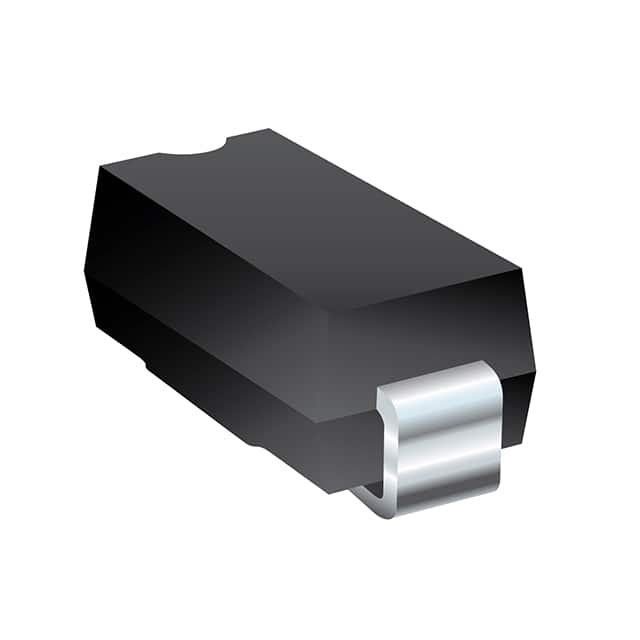Xem thông số kỹ thuật để biết chi tiết sản phẩm.

SMLJ13A Diode: Encyclopedia Entry
Introduction
The SMLJ13A diode is a crucial component in electronic circuits, belonging to the category of transient voltage suppressor (TVS) diodes. This entry provides an overview of the basic information, specifications, pin configuration, functional features, advantages and disadvantages, working principles, application field plans, and alternative models of the SMLJ13A diode.
Basic Information Overview
- Category: Transient Voltage Suppressor (TVS) Diode
- Use: Protecting sensitive electronic components from voltage spikes and transients
- Characteristics: Fast response time, low clamping voltage, high surge current capability
- Package: DO-214AB (SMC), SMA package
- Essence: Provides overvoltage protection for electronic circuits
- Packaging/Quantity: Available in tape and reel packaging, with varying quantities based on manufacturer specifications
Specifications
- Peak Pulse Power: 3000W
- Breakdown Voltage: 13V
- Clamping Voltage: 21.5V
- Maximum Reverse Standoff Voltage: 11.4V
- Operating Temperature Range: -55°C to +150°C
- Storage Temperature Range: -55°C to +150°C
Detailed Pin Configuration
The SMLJ13A diode typically consists of two pins, with the anode and cathode connections clearly marked on the package. The pin configuration follows industry-standard conventions for TVS diodes.
Functional Features
- Transient Voltage Suppression: Rapidly clamps excessive voltage levels to protect downstream components
- Fast Response Time: Reacts quickly to voltage transients, minimizing the risk of damage
- High Surge Current Capability: Can handle substantial surge currents without degradation
Advantages and Disadvantages
Advantages
- Effective protection against voltage spikes and transients
- Fast response time ensures minimal impact on circuit operation
- High surge current capability enhances reliability in harsh environments
Disadvantages
- Clamping voltage may be higher than some alternative models
- Limited to specific voltage ratings, requiring careful selection for different applications
Working Principles
The SMLJ13A diode operates by diverting excess voltage away from sensitive components when a transient event occurs. When the voltage exceeds the breakdown voltage, the diode rapidly conducts, providing a low-impedance path for the excess energy to dissipate.
Detailed Application Field Plans
The SMLJ13A diode finds extensive use in various applications, including: - Power supply units - Communication equipment - Automotive electronics - Industrial control systems - Consumer electronics
Detailed and Complete Alternative Models
Several alternative models to the SMLJ13A diode include: - P6KE13A - 1.5KE13A - SA13A - BZW04-13B - SMF13A
In conclusion, the SMLJ13A diode serves as a critical component in protecting electronic circuits from voltage transients and spikes. Its fast response time, high surge current capability, and effective transient voltage suppression make it a valuable asset in various electronic applications.
Word Count: 443
Liệt kê 10 câu hỏi và câu trả lời thường gặp liên quan đến ứng dụng SMLJ13A trong giải pháp kỹ thuật
What is SMLJ13A?
- SMLJ13A is a transient voltage suppressor diode designed to protect sensitive electronic components from voltage spikes and transients.
What is the maximum clamping voltage of SMLJ13A?
- The maximum clamping voltage of SMLJ13A is 21.5 volts at 10A.
What are the typical applications of SMLJ13A?
- SMLJ13A is commonly used in surge protection for telecommunications equipment, power supplies, industrial controls, and automotive electronics.
What is the peak pulse power rating of SMLJ13A?
- The peak pulse power rating of SMLJ13A is 3000 watts for a 10/1000μs waveform.
How does SMLJ13A provide overvoltage protection?
- SMLJ13A diverts excessive current away from sensitive components by clamping the voltage during transient events.
What is the operating temperature range of SMLJ13A?
- SMLJ13A typically operates within a temperature range of -55°C to 150°C.
Can SMLJ13A be used for ESD protection?
- Yes, SMLJ13A can be used for electrostatic discharge (ESD) protection in various electronic circuits.
What is the reverse stand-off voltage of SMLJ13A?
- The reverse stand-off voltage of SMLJ13A is 13 volts.
Is SMLJ13A RoHS compliant?
- Yes, SMLJ13A is compliant with the Restriction of Hazardous Substances (RoHS) directive.
Are there any recommended layout considerations when using SMLJ13A?
- It is recommended to minimize the length and area of the traces connecting SMLJ13A to the circuit to reduce inductance and improve transient response.

